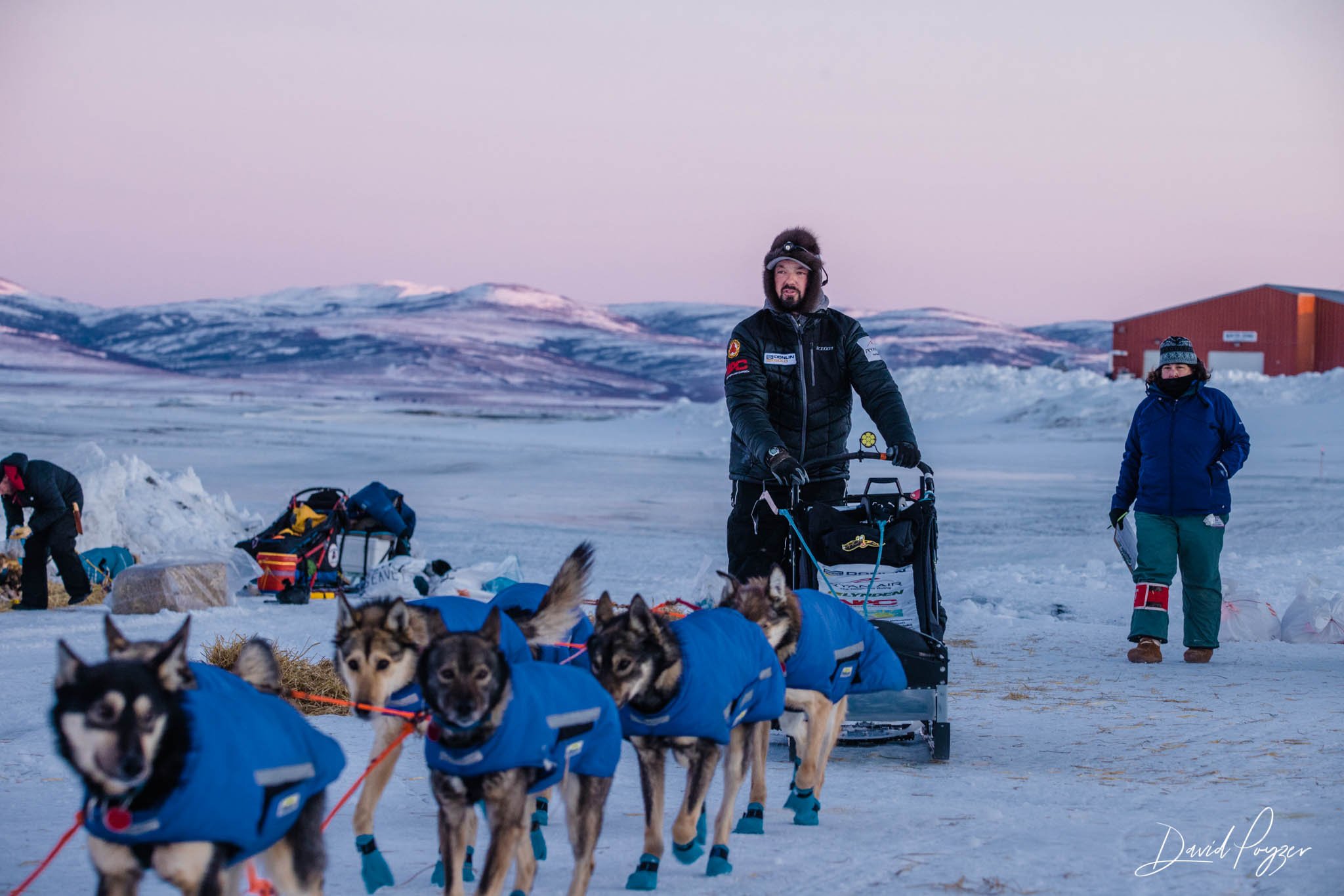A dog team
The super-lead dogs Sivo and Britt, with Hunter behind in point or swing position.
Credit: Mille Porsild – http://facebook.com/RunningSleddogs http://facebook.com/RunningSleddogs
The lead dogs in a dog team are the first dogs down the trail, but a dog team, is really that: a team of dogs. Every dog in a team is crucial to the overall performance of the team.
That said dogs that are considered lead dogs can almost always run any position in the team, while all dogs in the team rarely can run in the lead position!
A lead dog will not only be thrilled to lead the rest of the pack down the trail, but also will take commands from the musher to steer the team, turning the team right and left onto different trails, around obstacles and pass for example competing teams. Lead dogs have to have confidence in what they are doing and the drive to be the first ahead of everyone else. It is optimal for a musher to have many dogs in a team that have the skill and desire to lead the team. If a musher has the opportunity to often shift around what dogs are in lead, there is less risk of tiring out a lead dog. That said, some lead dogs thrive only when they are in lead and are seen to be up there for most if not all of races. A brilliant lead dog steers like a car, reads the terrain moving the dogs to the best surface and is competitive knowing its racing and wanting to ‘be first.’ In long-distance racing most often mushers run with two lead dogs, but sometimes leaders are run ‘single lead.’ This can be because trail conditions such as deeper snow make it easier for just one dog to run in front, or simply because this one particular dog prefers to be ‘alone in command’!
The other positions in the team are called ‘Swing dogs’ or ‘Point dogs’, followed by ‘Team dogs’ and last closets to the sled ‘Wheel dogs.’
Swing – or point is the position right behind lead. Dogs running in this position support the lead in taking commands from the musher, swinging the team to take turns right and left. It is often these front dogs that are really driving speed, setting pace behind the leaders. Some dogs run phenomenally in this position, yet still do not want to lead. This is often a matter of not having the persona: the confidence or ability to deal well with the pressure of ‘being in charge.’ Dogs still learning to lead but not yet with all the knowledge of a leader are often run in this position, where they can learn from watching the leader ahead of them without carrying the responsibility.
Team is position ‘in the middle of the team,’ where most of the dogs are running. All dogs in a team can likely run in the team position. However, don’t underestimate the importance of the dog that ‘just runs team.’ This is the worker bee position so to speak. Keep a constant steady hard pull, moving the sled and the team down the trail. This is most often where the ‘power houses’ that propel the team forward are running in long-distance mushing.
Team dogs flying down the trail during late fall training
Credit: Mille Porsild – http://facebook.com/RunningSleddogs
In traditional freight dog teams, where the purpose is to move a heavy load possibly on a slow or no trail at all, it is common to see the most powerful pullers running in the position right in front of the sled. However in long-distance racing, the often very long dog team moves at such a pace, with a light load (relative to a freight team), often on winding trails. In that case it is optimal to have the powerhouses further up into to team and instead have very agile yet hardened dogs running in the position right in front of the sled. This is the wheel position. Running in wheel is a lot of work. Not only are these dogs first inline to start the sled from a stop, but also they will feel the most impact from the sled ‘bumping’ down the trail.
The two brilliant wheel dogs Sok and Jesus, ready to roar!
Credit: Mille Porsild – http://facebook.com/RunningSleddogs
The sled is connected to the dogs running attached to a long line – most often in English referred to as the ‘main line,’ ‘tow line’ or ‘gang line.’ Starting at the back and approximately every 6 to 8 feet (2 to 2.5 meter) thereafter, two short lines are attached connecting to the back of two dogs; these are called ‘tug lines.’ In this way the dogs are running in pairs – a style of running dogs known as ‘gang line hitch,’ ‘nome hitch,” or ‘Alaska hitch.’ A short line can also be connected to the neck of each dog, known as a ‘neck line.’ This type of hitch keeps the dogs moving easily and safely on narrower trails like going through the woods or through harrowing mountain passes.
An Iditarod team heading across the sea ice as a unit.
Credit: Mille Porsild – http://Facebook.com/RunningSleddogs
Other styles not used in long-distance mushing are single-file or ‘trap line hitch’, which is excellent in very deep snow, and ‘fan hitch’ where each dog is on a very long individual trace attached to the sled spreading the dogs out like fingers on a hand. This has advantages when traveling across sea ice in the high Arctic as it spreads out weight distribution and provides a lot of freedom for each dog to take the slack needed to jump across obstacles of rough ice and crossing open leads in the ocean, with even heavy loads.
Single file and fan hitch are the more traditional hitches. The hitch used in long-distance racing was introduced to the mushers of the famous World Champion Dog Race at the Northern Manitoba Trapper's Festival (aka "The Pas") in 1920. A passage from the scrapbook of Roy H. Johnson reads:
“ In the race of 1920, Walter Goyne, who was born in Ruby, Alaska, made history when he came out of the frozen hinterland of Alaska to compete in the early Le Pas Dog Derby. When Mr. Goyne arrived in The Pas that day many years ago, he discovered that all the local mushers were using an old style toboggan for racing, with their dogs hitched in tandem single file. Goyne brought with him the famous Alaskan dog sled with his dogs hitched in the now famous Alaskan hitch, that is, dogs are two abreast with the leader centering the team in front. Northern Manitobans of that era were quite skeptical of Goyne’s sled and “new” hitch and in fact gave him little chance of winning that race of 1920. But when the race was over, and Goyne had won by an easy margin, the skeptics were forced to eat humble pie. Today Goyne’s Alaskan hitch and sled is being used by all famous mushers in Northern Manitoba, the East and the St. Paul Winter Carnival whose dog races date back to 1889.”
…And to that we may now add: all the long-distance races in the world.




































